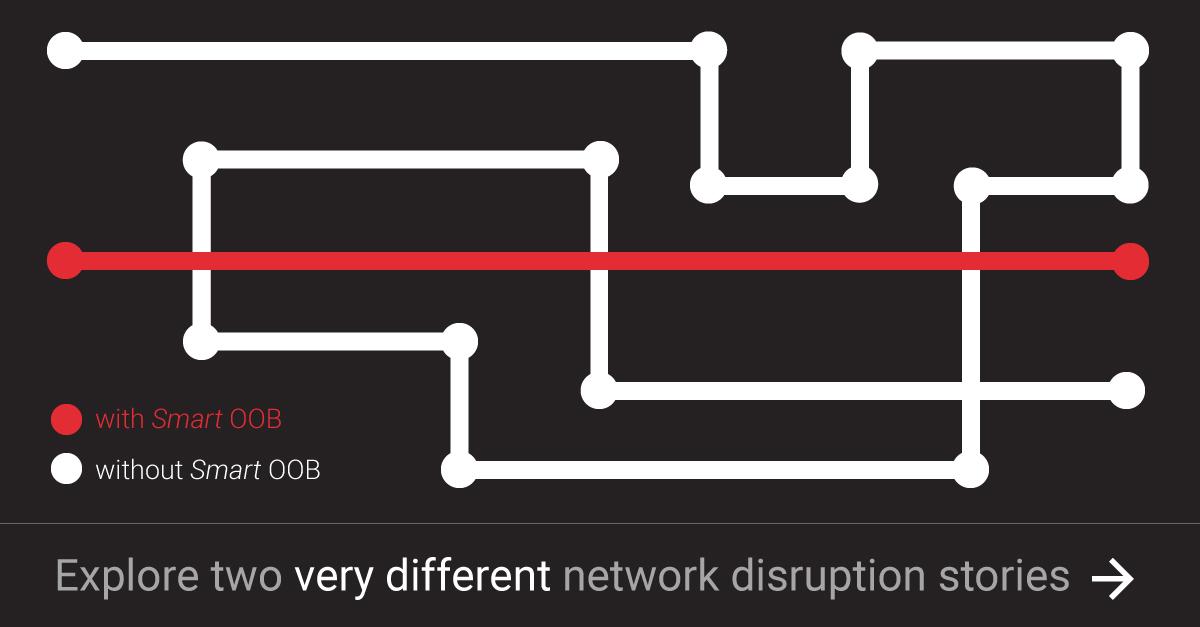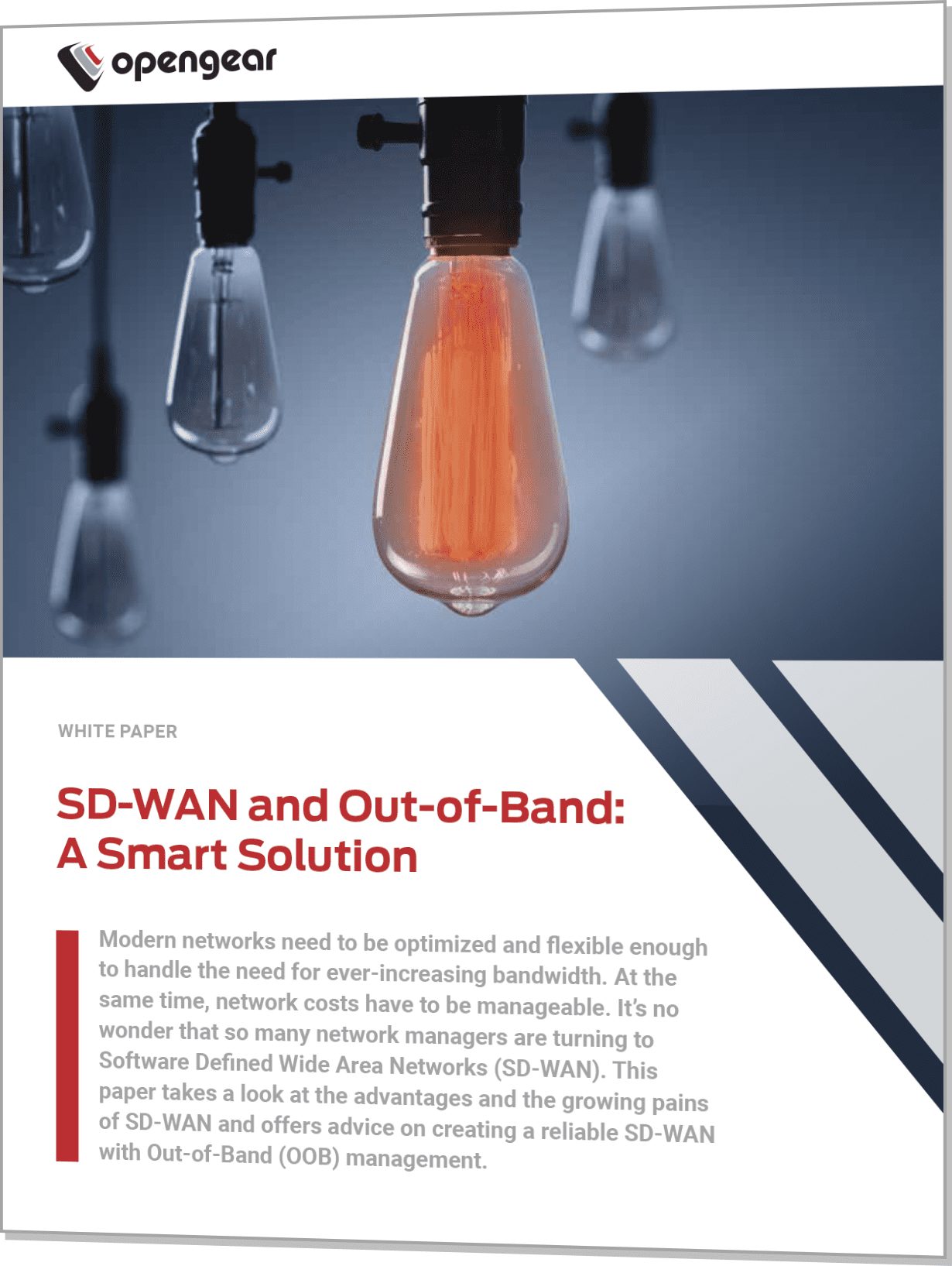Blog Archives
Out-of-Band Management
Resilience for Your Network
Out-of-Band management’s primary application is to provide secure, remote access to your critical resources even when the primary network is down. It offers presence and proximity to your distributed network, with a console server at every location, physically connected to routers, switches and key hardware. The addition of 4G-LTE provides a secure alternative access path, and Failover to CellularTM provides enough bandwidth for critical processes to continue to operate during an outage. When the network goes down, Out-of-Band keeps you running.
First Day, Worst Day, and Every Day
Is it smart to rely on the Production network to manage your network every day? With secure remote access to your devices via the console servers, Out-of-Band (OOB) management creates an always-on independent management plane, giving you reliable access to monitor and manage your IT infrastructure. Lock down the most critical functions on the Production network, and use the more secure OOB network to configure and manage your devices. Out-of-Band is the Network Engineer’s Network.
An investment in Out-of-Band Management is an investment that pays off every day.
- Secure Day One provisioning is now possible, using an OM2200 or OM1200 with embedded physical security, capable of running Docker containers and Python scripts.
- Everyday management and monitoring of your IT infrastructure is more secure and more resilient over the independent management plane, separate from the Production network
- Global cellular modules and centralized management software ensures access to your critical devices to fix the issue, when the primary network goes down
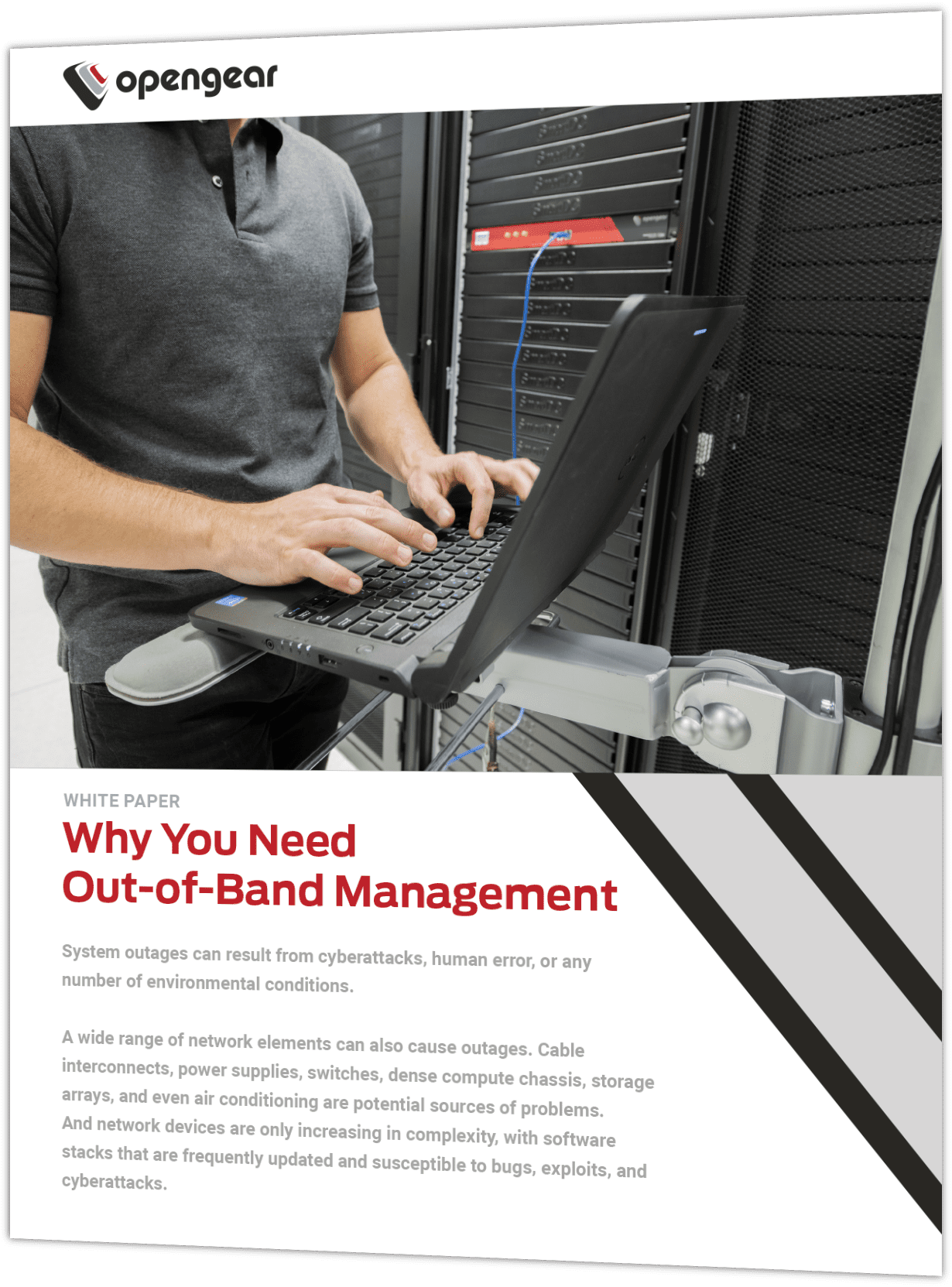
Resilience in the Data Center
Smart OOB allows organizations across the globe to ensure resilient backup connectivity, seamlessly access devices in remote data centers and reduce costs. Opengear’s console servers and infrastructure management solutions provide resilience and dependability to improve management functions.
Learn how cloud provider Secura Hosting utilized Smart OOB to reduce the time-consuming nature of dispatching engineers to its data center sites to make configuration changes and troubleshoot issues. Having deployed Smart Out-of-Band by Opengear, they’ve improved their management capabilities which led to a return on investment in just seven months
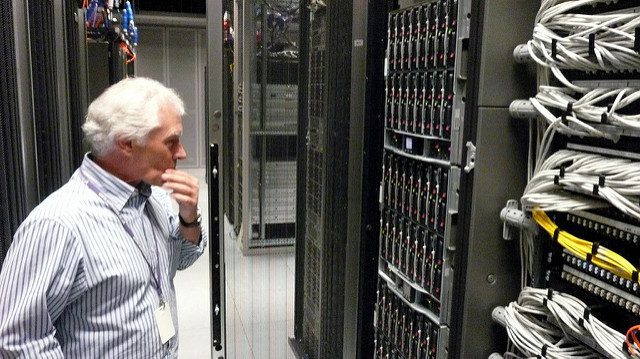
Case Study: Secura Cloud Hosting
An Edge Network as Reliable
as the Data Center
Your customers expect the same level of service, no matter where their data comes from. As computing moves closer to the edge of the network, the high uptime of a data center must be translated to small, remote locations. With no engineer on site, and with physical redundancy cost-prohibitive at each location, you need an alternative approach to resilience. Always-on access to an independent, secure management plane via a centralized software system provides a way to monitor and remediate issues at your edge locations without sending someone to site. Out-of-Band adds resilience to your network.
In an independent survey of 500 Global IT Leaders, 49% said that Network Resilience was their #1 Priority.

The Necessity Of Network Resilience in a Distributed Enterprise
 The choice of a distributed architecture for an organization is usually determined by the business requirement to support its remote office base at the same level as its main office. Branch offices broaden the reach of the business and are usually a sign of successful business growth. However once the decision to expand with branch offices has been taken, these offices instantly increase the responsibility of the IT/Network Manager who has to ensure (more…)
The choice of a distributed architecture for an organization is usually determined by the business requirement to support its remote office base at the same level as its main office. Branch offices broaden the reach of the business and are usually a sign of successful business growth. However once the decision to expand with branch offices has been taken, these offices instantly increase the responsibility of the IT/Network Manager who has to ensure (more…)
Connecting Your Customers (MSP White Paper)
 Enterprises rely on Managed Service Providers (MSPs) to provide constant uptime. To meet the growing needs of customers, MSPs require advanced tools that can monitor devices remotely, from a wide range of vendors. Not being able to provide the proper management, monitoring, and reporting expected by customers can lead to lost revenue as well as decreased customer retention.
Enterprises rely on Managed Service Providers (MSPs) to provide constant uptime. To meet the growing needs of customers, MSPs require advanced tools that can monitor devices remotely, from a wide range of vendors. Not being able to provide the proper management, monitoring, and reporting expected by customers can lead to lost revenue as well as decreased customer retention.
This white paper will explore the challenges of MSPs and provide solutions on how to ensure network resilience with an independent management plane.
Download our whitepaper to:
- Learn about challenges that can occur when managing multiple networks
- Understand the top reasons why customers switch MSP vendors
- Ensure network uptime and differentiate offerings
Secure Provisioning Over Your Out-of-Band Network
Throughout the world, everyone’s working lives have suddenly become remote and because of this, visibility has become increasingly important. Social distancing and remote working have now become the norm, and tasks that are critical to business continuity, like going on-site to remediate issues during a disruption or set up a new network, are no longer an option. Lighthouse Enterprise is here to alleviate those issues.

Secure Provisioning in A Remote World
Lighthouse Enterprise already provides network engineers the ability to view and manage their entire network. Now our users are able to take advantage of our new Secure Provisioning Module. Enabling teams to automate the setup of entire remote networks, even when there’s no LAN or WAN in place, the module is a central point that enables the remediation of faults without making a trip out to a site.
Secure Provisioning extends these core capabilities of Smart Out-of-Band, beyond the maintenance and repair of existing networks, to the initial provision of new network routers, switches, firewalls and more. Remote and resilient, it takes the risk out of invasive WAN migration projects and forklift upgrades that have historically come at the expense of business continuity. Secure Provisioning enables an agile approach to network infrastructure management, in line with today’s rapidly evolving business requirements. It helps Ops teams move beyond the “fear culture” and embrace change.
Leveraging the remote presence and proximity of Opengear’s IM7200, ACM7000-L or node at the edge with a secure and resilient cellular uplink to Lighthouse at the core, it eliminates the need for network engineers to travel to remote sites, which it has already been connected to during pre-staging. Basic configuration tasks and pre-staging, which is already done remote, can now be all be done remotely.
Lighthouse Enterprise automatically pushes images, configuration, and script files to the device, which in turn provisions other hardware devices at the remote site. This completes the secure, zero-touch provisioning of local network infrastructure from a single appliance – and with no IT intervention required.
Built on best-practice DevOps tools like Git and Ansible, wrapped in an intuitive UI and powerful RESTful API, Secure Provisioning seamlessly integrates into existing operational workflows – no matter where your organization is on its network automation journey. Secure Provisioning extends the reach of Zero Touch Provisioning (ZTP), initially developed for rapid deployment in hyperscale data centers, to the very edge of your network. With support for all major network infrastructure vendors including Cisco, Arista, and Juniper, Secure Provisioning is a vendor-neutral solution that simplifies the delivery of initial configuration and software components to automatically bring network infrastructure online or back online.
Ensuring Connectivity In The Age Of SD-WAN
The Software Defined Wide Area Networks (SD-WAN) market is rapidly expanding, becoming the standard in enterprise deployments. According to MarketsandMarkets1, the global SD-WAN market size is expected to grow from $1 billion in 2018 to $ 4 billion by 2023.

In just the past year alone, we’ve seen a considerable trend when it comes to choosing to deploy SD-WAN and for many reasons. Allowing traffic to be routed over the most cost-effective services, such as broadband, an SD-WAN network can manage multiple types of connections including LTE, broadband and multiprotocol label switching (MPLS) links. Services that require high quality, such as video or voice, or high security, with sensitive information, can still be routed over remaining MPLS lines, although many enterprises are freeing themselves of MPLS entirely, allowing them to invest in Smart Out-of-Band with the savings. Because of this flexibility, SD-WANs can dramatically lessen the cost and minimise the complexity of traditional WANs. However, despite it’s gaining popularity, with deployments in data centers and at the edge, it still needs an alternative path of access to the network in the event of an outage.
SD-WAN Points Of Failure
In traditional branch networking, branch routers can go for years without needing any intervention like configuration changes or firmware updates. But SD-WAN routers are more sophisticated and run a larger software stack. Firmware updates are common which means that there are many more opportunities for things to go wrong. Updates can leave organizations vulnerable to potential downtime; and visibility blind spots can decrease the effectiveness of deployments, creating security challenges.
SD-WAN also needs additional security offerings to protect an enterprise. The primary SD-WAN connection must be secure and must be added to any other security solution being deployed. These devices are usually fully meshed which means that compromising one device can give attackers visibility into the traffic flow from across the enterprise.
The Smart Solution
Smart out-of-band management by Opengear allows enterprises to bypass these common limitations. Not only does it provide an alternative path to devices located at remote sites when the primary network is down, helping mitigate the risk that SD-WAN can bring, it can also help facilitate access to edge infrastructure to ensure business continuity.
Attaching Opengear to SD-WAN deployments:
Diagnoses the issue: If a disruption occurs and the internet link isn’t connected, outages are detected immediately. Paired with Lighthouse Centralized Management, administrators are able to identify issues and remediate them remotely without having to roll a truck out to a site.
Allows for always-on access: Failover to Cellular paired with Smart Out-of-Band ensures uninterrupted availability for remote networks with 4G LTE. This allows organizations to continue business as usual while the primary internet connection is down.
Decrease costs: A Smart Out-of-Band solution costs less to deploy and operate. A truck roll and a few hours offline can cost an organization thousands of dollars.
Designed to provide the needed resilience at the edge, Smart Out-of-Band by Opengear is scalable, providing the ability to manage infrastructure at distributed sites. Troubleshooting and remediation at the network’s edge enables organizations to detect faults before they become failures which minimizes downtime and operating costs.
Providing organizations with always-on connectivity and increased resilience in the event of an SD-WAN network failure, Smart Out-of-Band is able to ensure that infrastructure is accessible from anywhere during an outage. This resilient backup connectivity allows enterprises to reduce the time-consuming nature of dispatching engineers to data centre sites to make configuration changes and trouble-shoot issues for business continuity. Smart Out-of-Band and Failover to Cellular™ ensures that SD-WAN continues to operate when all other circuits are unavailable, providing the always-on access needed at the edge. So the next time you’re deploying SD-WAN, remember to attach Smart Out-of-Band.
1 https://www.marketsandmarkets.com/Market-Reports/software-defined-wan-market-53110642.html
Why You Need Out-of-Band Management (White Paper)
System outages can result from cyberattacks, human error, or any number of environmental conditions. A wide range of network elements can also cause outages. Cable interconnects, power supplies, switches, dense compute chassis, storage arrays, and even air conditioning are potential sources of problems. And network devices are only increasing in complexity, with software stacks that are frequently updated and susceptible to bugs, exploits, and cyberattacks.
If your primary network becomes unavailable, do all parts of your network, from data centers and branches to edge networks and IoT devices, have connection resilience? As your business grows, your network becomes increasingly complex and new deployments or acquisitions may lack the ability to connect seamlessly through the internet.
Reading this white paper you will learn:
- What can cause an outage
- The difference between In-Band and Out-of-Band management
- Advancements made with Out-of-Band management console servers
Like what you’ve read here? Subscribe below to be notified of any future content released by Opengear.
(You do not need to fill out this form to get the white paper)
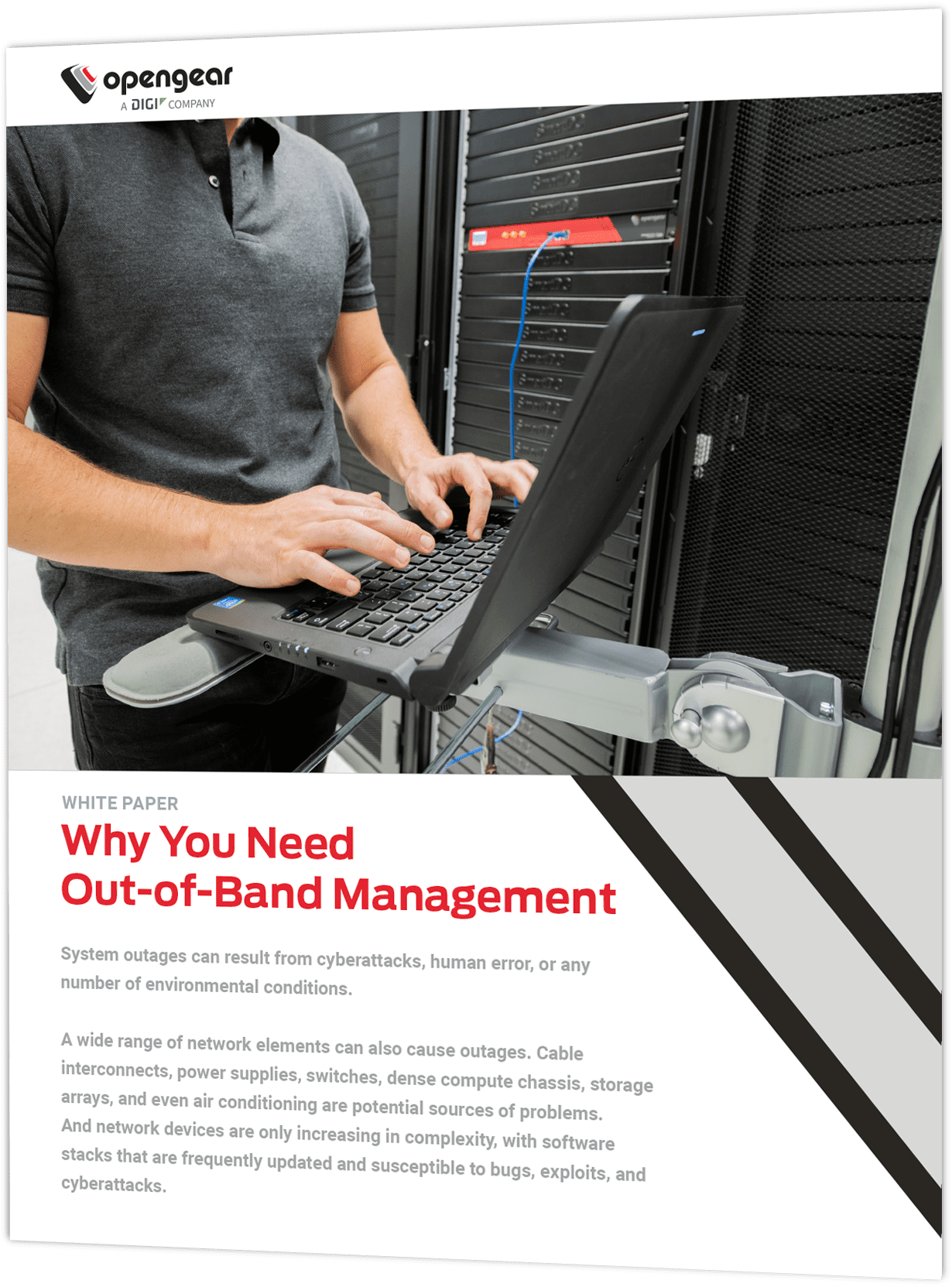
Global Retail Network Boosts Resilience
Global Retail Network Boosts Resilience with Opengear Solutions
See how a global retail company increased network resilience at its stores and point of sale locations with always-on access, thanks to Opengear’s Smart Out-of-band and Lighthouse Centralized Management software.
To learn more, visit https://opengear.com/retail
OOB, The Safety Net For WAN Edge
WAN Edge continues to be a large focus for IT Professionals worldwide. Data is being consumed at an ever-increasing rate with Online Meetings, Video Presentations and SaaS software and services dominating knowledge workers’ days. The high cost of equipment and leased lines are prohibitive to IT budgets. Keeping up with the needs of a branch office in 2019 is difficult, and more importantly expensive, often forcing difficult decisions on everyday needs.
SD-WAN is quickly becoming the standard deployment for organizations worldwide for many reasons. One of its many benefits is that it helps combat inflated budgets and limited functionality in traditional WAN offerings. While these new offerings provide the ability to use commodity connectivity and include additional functionality at the Edge, they fail to deliver on a key feature that is required by IT departments, failsafe access in outage scenarios. Out-of-Band (OOB) options should be included in any branch office and data center build out. This has not been the case with early adoption of SD-WAN, as organizations are often led to believe it’s not necessarily needed.
SD-WAN Opportunities and Limitations
Most SD-WAN solutions support service orchestration (mainly cloud-based) from the central controller, reducing human intervention so the end user has to do little, to nothing. The devices call home and the bootstrap, configuration and management processes are engaged automatically.
All of this however, relies on the SD-WAN working well. As the SD-WAN starts to waver and begins to fail you cannot always rely on the SD-WAN to fix its own problems. Under those circumstances it will likely lose communications with the central controller and go offline, and someone has to diagnose and/or replace appliances since the umbilical cord is cut.
SD-WAN nodes will occasionally go offline or struggle and there’s no inbuilt magic to stop it. The reasons may vary but an offline SD-WAN node is a big deal and it may happen through –
- Last Mile Connectivity Failures (i.e. massive link failures)
- Configuration/Firmware Corruption (fat fingers and flash problems)
- Hardware Appliance Frozen/Hung (Bugs with immature SW)
- Appliance Cyber-attack/vulnerability DDOS (hacking…)
- Power Glitch (reboot into a bad state)
Often SD-WAN is sold as ultra-reliable because it supports bandwidth aggregation and traffic splitting over multiple disparate links (cable, xDSL, MPLS, fiber…) with flexible use-cases because it employs methods to prioritize traffic according to application latency. However, SD-WAN does introduce new limitations which include reduced access to supported hardware, difficult to configure advanced features, and varied access or no access to remote troubleshooting.
SD-WAN + Smart OOB = Enterprise-Grade WAN
Opengear’s Smart Out-of-Band (Smart OOB™) manages and recovers SD-WAN nodes even when sites have or are beginning to fail. OOB enables remote setup, ongoing maintenance and disaster recovery of mission-critical IT, power and network infrastructure. By moving computation to the data – as opposed to moving data to the computation, businesses get unmatched speed and effectiveness in managing remote devices. You have options for understanding what happened in real time and getting productivity back without the added burden of having to be onsite.
No-one else has a feature-for-feature equivalent to Smart OOB appliances and centralized management through Lighthouse. Opengear offers site fail-over through cellular connected appliances, Remote System Access, Health and Telemetry monitoring, Remote Power Control, Auto-remediation through smart alerts and actions and SD-WAN appliance reconfiguration from local storage.
Opengear delivers improved resiliency for SD-WAN and for the rest of the edge network. We have become the safety blanket around the WAN Edge where virtualized customer premises equipment (vCPE) platforms or software-defined WAN (SD-WAN) software/appliances are set to boom and it’s the same comfort we provide to keeping traditional routers on-line.
A Smart Solution For SD-WAN Deployments
Software Defined Wide Area Networks (SD-WAN) are being used by organizations to reduce costs and improve flexibility needed for bandwidth demands. Dynamically sharing network bandwidth across a variety of connections, traffic is able to be redirected to the most cost-effective route like broadband or LTE.
SD-WAN is more than just a buzzword, it’s become the standard in enterprise deployments. Projected to reach $8 billion¹ in market value by 2021, organizations are understanding the benefits of this low cost, agile alternative to traditional branch routers, it allows organizations to get rid of expensive MPLS (Multiprotocol Label Switching) circuits and rely on 4G LTE. Despite it gaining popularity and being deployed in data centers and branch locations across all industries, it still needs an alternative path of entry to the network in the event of an outage.
Deploying SD-WAN, You Need Smart Out-of-Band
SD-WAN is quickly being adopted, because of its simple management and configuration although it does have some points of failure. In traditional branch networking, many times branch routers can go years without needing configuration changes or firmware updates. Cloud-based provisioning does allow for a simple configuration of the SD-WAN router, however this is still considered in-band management. The solution to ensuring that network events don’t become disruptions is Smart Out-of-Band management (Smart OOB™).
Smart Out-of-Band enables organizations to securely monitor and manage all devices within a data center or remote location without interrupting normal operations. Designed to meet the needs of hundreds of sites and thousands of devices at those sites, organizations are able to reduce costs using advanced troubleshooting and remediation at the network’s edge.
Smart Out-of-Band and the Edge
Why is it so important this is all completed at the network’s edge? The edge enables analytics and data gathering closer to the sources of that data. By identifying issues at the edge, network engineers are able to remediate the issue quickly, avoiding unnecessary costs that can occur from an outage. If during an SD-WAN deployment a network event does occur, Smart OOB will be able to get the network up and running remotely
Providing organizations always-on connectivity and increased resilience in the event of an SD-WAN network failure, Smart OOB is able to ensure that infrastructure is accessible from anywhere during an outage. Opengear’s white paper on Enterprise-Grade WAN provides more detail on the combination of Smart Out-of-Band management with an SD-WAN deployment.
Allow your organization to:
- Ensure that infrastructure is accessible during system and network outages
- Detect faults before they become failures
- Allows organizations to have a faster recovery if IT and network failures occur
1 https://www.idc.com/getdoc.jsp?containerId=prUS42925117
Why SD-WAN Needs Smart Out-of-Band
SD-WAN is more than just a buzzword, it’s become the standard in enterprise deployments. Projected to reach $8 billion¹ in market value by 2021, organizations are understanding the benefits of this low cost, agile alternative to traditional branch routers.
Being able to dynamically share network bandwidth by choosing the most efficient path, SD-WAN allows enterprises to eliminate expensive private network circuits and still balance traffic.
Although SD-WAN has a lot of benefits, there is one drawback to these sophisticated devices. SD-WAN routers run on large stacks of software which require constant firmware updates. These are a necessity, but we all know more updates increases the chance for network events to become large, costly disruptions – with the cost of downtime being $5,600 per minute², outages are something that most organizations can’t afford. The solution that can reduce the impact of these events – Smart Out-of-Band™ (Smart OOB) from Opengear.
Top 3 Reasons
1. Diagnoses the issue
Everyone’s gotten that dreaded call at 3 am, there’s an issue with the network and without Smart Out-of-Band, more often than not, network administrators are left scratching their heads wondering what to do and where to start. Identifying the source of an outage without visibility across the network can take hours and to make matters worse, this all could’ve occurred at a site hundreds of miles away. Instead of wasting hours driving to a site to troubleshoot, Smart OOB allows network administrators immediately and remotely fix the issue.
2. Allows for always-on access
No enterprise can afford the costs associated with an outage – and without complete network visibility, these disruptions could last for days. Opengear devices deliver reliable access when needed. Smart OOB allows organizations to begin troubleshooting issues. Failover to Cellular, ensures continued internet connectivity for remote LANs and equipment with high speed 4GE when the primary internet link is down, delivering resilience.
3. Decreases costs
An organization that doesn’t have Smart OOB can spend thousands of dollars in just a week when a network error occurs. Having to send staff and truck rolls out to the site is costly let alone the time it takes to identify the issue once they are there. Smart OOB allows network administrators to remediate the problem in minutes remotely.
SD-WAN + Smart OOB = Enterprise-Grade WAN
SD-WAN deployments provide flexibility and reduce costs while maintaining secure connections. Allowing enterprises to utilize and aggregate multiple bandwidth connections, these routers do introduce a single point of failure that can result in potential downtime. Smart OOB supports these deployments, giving staff the ability to remotely get networks back up.
Learn more about how Smart OOB can support your SD-WAN deployment.
¹ https://www.idc.com/getdoc.jsp?containerId=prUS42925117
² https://blogs.gartner.com/andrew-lerner/2014/07/16/the-cost-of-downtime/
What is Smart Out-of-Band Management?
What is Smart Out-of-Band Management?
Out-of-band management is at the heart of network resilience, and Opengear continues to focus on Smart OOB solutions that keep critical infrastructure running by developing faster access and monitoring, with more efficient management and control, and wider decision-making options.
https://opengear.com/solution/smart-out-band-management
This video is a quick overview of what Smart Out-of-Band is. For more information or to schedule a demo, visit our website.
